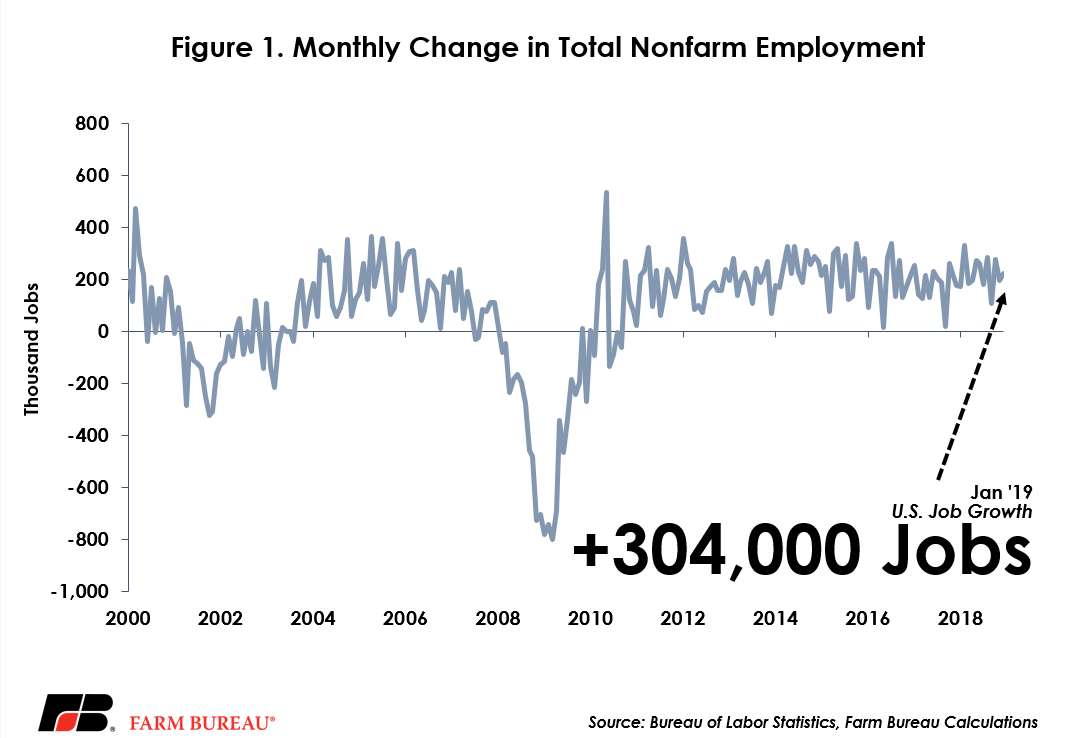January Jobs Report Shows Continued Growth
TOPICS
Market IntelBob Young
President

photo credit: Right Eye Digital, Used with Permission
Bob Young
President
If you are confused about the future path of the general economy, you are by no means alone. The jobs report for January indicated the economy added 304,000 new jobs with total employment at 150.6 million, up 1.9 percent from prior-year levels. It also revised the December numbers, dropping 90,000 slots from the originally reported 312,000 to 222,000. Still, the average monthly job gains over the last three months of 2018 was 241,000, which, along with the more than 300,000 additional positions for the first month of 2019, is a respectable showing. Figure 1 highlights monthly change in nonfarm payroll employment based on the Bureau of Labor Statistics’ Current Population Survey.

The big question this survey prompts is how the government shutdown affected the data. Digging into that issue, we’ll start with the survey timeline: Jan. 6-12. The Bureau of Labor Statistics was funded under an earlier appropriations action and, as such, was not closed during the survey period.
Let us also remember that overall federal employment – excluding postal service employees – totals 2.193 million, so the 800,000-furloughed-employees figure put out by the press is a significant proportion, but several of those positions were considered “essential” and those employees were brought in regardless of the shutdown.
Impact of Shutdown
Further, recall that the labor survey is done in two parts: the establishment survey that goes to companies/employers and asks them how employment changed and a household survey that asks individuals how their status has been adjusted since the previous month. Understanding these differences, the federal government still considered employees as just that, even though they may have not been paid during that period. Consequently, the establishment survey – with the federal government as the employer in this case – was essentially unchanged (actually it showed an increase of 1,000 jobs) in January, even with the shutdown. Federal contract employees are a completely different story, but even so, it is difficult to suss out exactly how those numbers moved this past month.
The household survey gives a little better picture as to the real impact on federal employees at the time of the survey. Officially a federal employee would have been considered “unemployed on temporary layoff.” There were 104,000 in this category, around 80,000 larger than historical data would suggest. Several thousand federal workers were also classified as “employed but absent from work.” There were 239,000 people reporting this classification, as opposed to 77,000 in that category in December.
Taken together then, the data suggest there were roughly 242,000 (80,000 + 162,000) federal employees who were considered out of work during the survey period. Again, that is from the household survey. The establishment survey – which is used to calculate the job creation data – indicated the shutdown had no effect on employment.
One indicator of the effect on federal contract workers is the number of people at work part time for economic reasons. This figure increased by around 500,000 slots in January. As the explanatory note from the Bureau of Labor Statistics states: “Nearly all of this increase was in the private sector and may reflect the shutdown…”
Job Growth Across the Economy
With that out of the way, the strong employment report was driven by job gains across major categories. Leisure and hospitality combined for 74,000 new slots, with food service and drinking places (can’t say bars) adding 37,000 positions and amusements, gambling and recreation adding another 32,000. Construction was a surprising second, adding 52,000 jobs, with 19,000 and 15,000 in non-residential and residential, respectively. Infrastructure construction jobs also rose by 10,000.
Health care – a consistent source of 40,000+ new positions a month – came up with 42,000 new jobs, roughly half in the ambulatory health care services area (22,000) and hospitals (19,000).
Overall, retail trade gained 21,000 jobs, with sporting goods, hobby, book and music stores adding 17,000 slots. The traditional general merchandise stores, on the other hand, slipped by 12,000 positions. In total, retail trade has added only 26,000 jobs over the last year. Similarly, manufacturing and financial services were small positives at 20,000 and 13,000, respectively.
And probably most important of all, average hourly earnings increased again, albeit by only 3 cents an hour; but at $27.56 per hour, earnings in January 2019 were 3 percent higher than in January 2018.
Summary
The interpretation one might take from this report is that the economy is still doing okay. If companies feel optimistic enough to continue hiring at this rate, even in the face of all of the fog present in the marketplace, then someone believes. There are a number of other confusing signs which are often present when the economy is about to go through a phase change, but that is a subject for another column.
Trending Topics
VIEW ALL